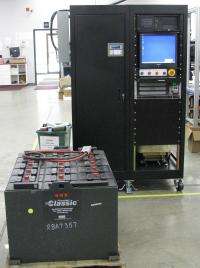April 8, 2013 weblog
Startup touts ultrafast charging: What if a smartphone could charge in 12 minutes instead of two hours?

(Phys.org) —Potential Difference Inc., a Nevada startup, has developed a versatile charger that it claims can refill the batteries in smartphones, laptops and even electric vehicles to 80 percent capacity in 12 minutes. That's a major improvement considering the Tesla Motors Supercharger needs 30 minutes to recharge 50 percent of a battery.
Dr. Yi Ding at the Georgia Institute of Technology first developed the technology in the late 1990s, and patented it in 2001. Now, Elliott Small, the CEO of Potential Difference, has acquired an exclusive license to commercialize the technology.
"We are working on partnering with manufacturers to integrate the technology with the battery of different consumer electronics," said Small. Potential Difference has already teamed up with Chargetek to manufacture the integrated circuits with the patented technology and is currently running a crowd funding campaign on Indiegogo.com.
Predominantly, energy storage research involves innovation in the materials used to design batteries and in their physical configuration. But this particular technology modifies the method of charging without altering batteries themselves.
The charger has sensors to detect the temperature, voltage and current charge level of a battery, and these data are used to determine the battery charge acceptance. Generally, batteries charge faster at low charge levels as compared to when they are already partially charged. By first determining the state of the battery, the charger can optimize the current pulses it sends.
"This is what makes it unique and different," said Scott Moura, a postdoctoral fellow in control systems and dynamics at the University of California, San Diego. "Batteries normally charge using a constant current but these chargers send current pulses."
Potential Difference has conducted testing on charger prototypes for lithium-ion batteries and its results show that common consumer electronics and electric vehicles can be charged fully within 16 minutes. While charging to 80 percent, the battery reached a maximum temperature of 42 degrees Celsius.
A major plus for implementation is that the charger is compatible with almost all consumer electronics. "The interface that connects the charger and device needs to be changed, but the charger remains essentially the same," Small said.
Originally, Potential Difference hoped to manufacture the chargers on its own but technological and market limitations pushed the company to connect with electronics manufacturers.
John Busbee, the CEO of Xerion Advanced Battery Corp., agrees that the charger will work best if customized to each electronic device. "It won't reach it's best potential without partnerships with the consumer electronics and battery manufacturers," said Busbee. "If the battery model is not reflective of the battery, it'll work, but it won't work as well."
However, Ding argues that the charging method is generic and depends mainly on basic battery chemistry. He feels that since most electric vehicles and consumer electronics use lithium-ion batteries, the specifications of the battery are immaterial. "That's the beauty of this kind of charging technique," Ding said. "It doesn't rely on who the producer is or the size of the battery." Since the charger first diagnoses the state of the battery before responding, Dr. Ding said the manufacturing details of each gadget are not required.
Moura is skeptical about the fast charging technique's effect on battery life. When high levels of current are applied, the internal resistance of the battery causes temperature rise and damage to the battery itself. Moura explains that since the electrodes in the battery are like a sponge soaking up lithium ions, sending high pulses of current repeatedly would cause repetitive expansion and contraction of the electrode, ultimately resulting in electrode fractures and battery failure.
Potential Difference has not yet conducted cyclical testing on the device and does not yet have data on how many cycles of charging an average battery can withstand.
(c) 2013 Phys.org/Naveena Sadasivam





















